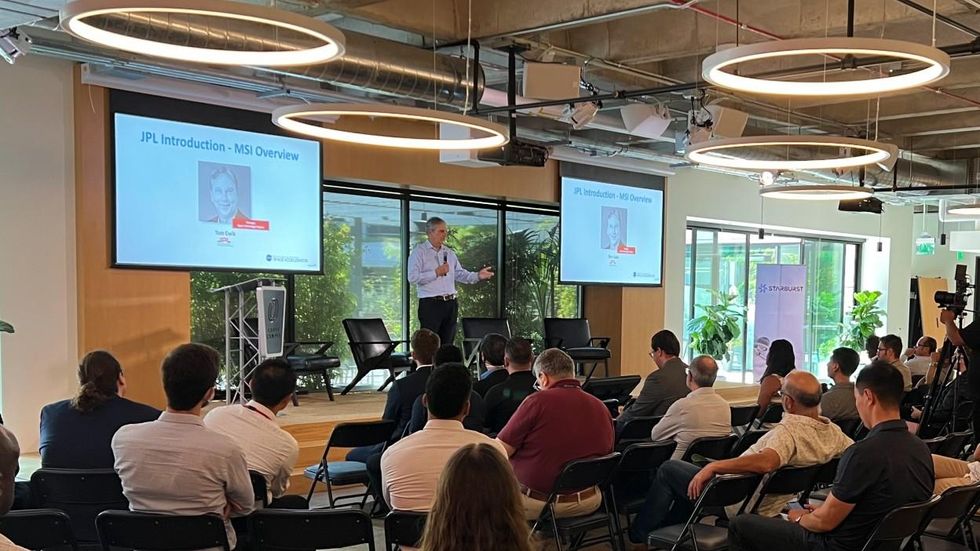As human space tourism ramps up, and we continue to explore deeper into the cosmos, one alarming fact is becoming more evident: Despite decades of human spaceflight, we still have very limited information about how going to space, or staying there for sustained periods of time, affects our bodies.
So far, flights to low Earth orbit are relatively stable, and thankfully no one has perished on a trip yet. But there’s also more to come; Virgin Galactic is planning more space tourism trips next year and beyond that, longer-term missions like Elon Musk’s pet project to colonize Mars could come with some serious health risks. And, like any mission to space, nearly every variable has to be considered before launch to ensure the people undertaking these journeys are as healthy as possible.
That’s where private industry comes in. There’s a handful of startups that are focused on developing technology to make it easier to monitor human health in space. And while it may seem like a far-away pipe dream, they’ll be the first to tell you that having startups begin to develop health care products for space-related exploration is key to ensuring there aren’t mass casualties.
“The truth is, there is little that is more complex than space, and biology, and these are not things that have fast development times,” said Elizabeth Reynolds, a biologist and director of the Starburst Aerospace Care in Space Challenge. The challenge recently awarded six winning startups (three were local to Southern California) a $100,000 investment from pharmaceutical company Boryung, support for on-orbit experimentation by Axiom, a Houston-based company making private space stations, and acceptance into Starburst’s 13-week accelerator program.
“As we talk about deep space exploration, that is a point where we get into high amounts of cosmic radiation and it's an environment that will kill us,” Reynolds said. “We need solutions that are completely untethered from Earth.” Reynolds said she was “less concerned” about space tourism, and more focused on long-term habitation.
Reynolds did note that there’s one easy option, one that NASA’s relied on heavily up until now: send robots into space to do human work. That’s possible, but she noted, “I cannot imagine a future where we continue to only explore space by robots.”
There’s a myriad of issues that people face when spending long durations of time in space. Some side effects can range from motion sickness to radiation poisoning to heart and muscle atrophy. Others include bodily fluid shifting due to zero gravity, changes in vision, loss of muscle strength and changes in gut biome behavior. Of course, there’s also a host of potential mental side effects too, including depression or anxiety. A 2021 study published in the Journal of Clinical Nursing noted that these effects can also persist even after a person comes back from orbit.
Kay Olmstead, CEO of San Diego-based NanoPharma Solutions, was one of the companies selected by Starburst. She told dot.LA the company is working on a way to deliver drugs to people in space to maximize their effects.
Olmstead told dot.LA., NanoPharma “uses [a] nanocoating method developed by NASA to nanosize drugs to improve biosorption – [the] smaller the particle size, better solubility of [the] drug, hence better absorption into our body which is mostly water.”
The importance of nano-soluble drugs is key, since it could limit side effects that come from typical ingestion of drugs, such as liver and kidney damage, or systemic toxicology (when a drug is absorbed by or distributed to other parts of the body besides the specific target area), Olmstead explained.
She added that NanoPharma is working on using vacuum pressure in low Earth orbit to deliver drugs to diseased organs without needles, a potential groundbreaking solution since right now, most life-saving drugs need to be administered via IV and that’s “not suitable for space travelers.” Instead, NanoPharma is working to patent several methods of drug delivery including a nano-nasal spray and a nano-inhaler.
Olmstead noted that there’s a number of companies working on private space stations – besides Axiom, she also cited Northrop Grumman, Nanoracks and Sierra Space, who all have “grand plans of infrastructure building in space for private space travelers and in-space manufacturing.”
There’s a couple dueling local companies with ambitions to build private space stations as well: Vast Space, and Orbital Assembly.
Olmstead noted that there will have to be construction workers in space overseeing building of these outposts, and added, “Care for these space travelers and workers is the most important concern of these aerospace companies aside from the station building/maintenance.” She also said that outposts on the moon, which will likely be built after stations in low Earth orbit, come with “even more severe health hazards.”
Another local startup that won the Starburst challenge was Vibo Health. Based in Los Angeles and led by physicist and CEO Gil Travish, Vibo develops wearable health tracking technology that uses wrist scanning to give users insight into their health, with the goal of finding health risks without invasive tests.
Right now, Vibo has a growing business terrestrially, but Travish told dot.LA he’s eager to see how the tech could be applied to astronauts. “It is a niche, of course, but it's a growing niche,” Travish said. He noted that Vibo hopes to do in-space testing within the next two years.
For now, though, both Vibo and NanoPharma said they will continue developing and testing their technology on the ground with the goal of bettering patients’ lives here on earth. Travish said he’s optimistic that the work will not only better conditions for space-faring humans, but also unlock information about the human condition.
“It’s not just about going to space, it’s about learning more about ourselves,” Travish said.


 Photo by Andria Moore
Photo by Andria Moore